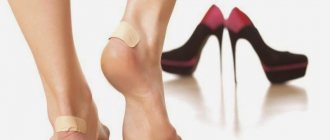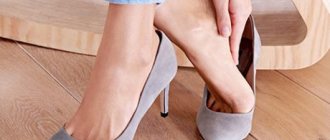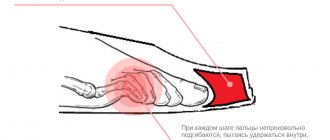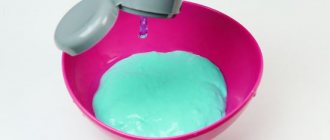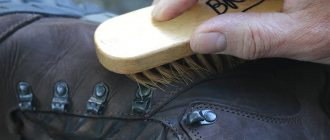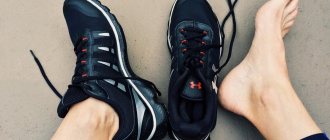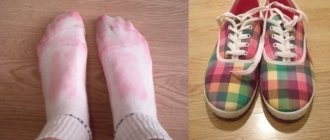Often, shoes that fit perfectly in the store begin to rub very hard on their first walk. If this happens, do not rush to throw away your new shoes or put them on a distant shelf. First of all, you can stretch your shoes by using the services of a shoemaker. Using special means and tools, the master will soften the material without damaging it. And immediately after that, you will be able to wear new shoes without experiencing any discomfort.
However, if you do not have the opportunity or desire to contact a professional, you can correct the situation yourself. Today there are many ways to quickly and safely get rid of the problem. We are talking about both stretchers, which can be found in shoe stores, and folk recipes.
So, what and when to use, as well as what you need to remember when treating shoes at home - let's take a closer look.
What to do at home if it rubs a lot?
Important! Before you start taking any measures, figure out why your shoes suddenly became uncomfortable. Sometimes it turns out that the problem is not even in the product. For example, if you suffer from excessive swelling of your feet, any shoes will chafe during long walks. And this problem needs to be solved not by home methods, but in the office of an orthopedic doctor. However, as a rule, the cause of discomfort is one of the following factors:
- Wrong size. Regardless of whether the product is small or large, if it is chosen incorrectly, the shoes will rub, which will lead to the formation of calluses;
- Hard material. Most often this concerns backdrops. If they are too hard, you will have to put up with unpleasant sensations for the first time after purchase. They will disappear when the shoes are worn in or you soften them in some way;
- Wrong model. The product should fit well on the leg, fitting it tightly: not too tight and not too loose. Each person has an individual foot shape, so what your friend wears with pleasure may not suit you at all. Keep this in mind when purchasing new shoes or boots. The ideal option is to order shoes made specifically according to your measurements.
Remember, if your shoes start to chafe, it is important not to put off solving the problem until later. Don’t wait for calluses to appear, because preventing their occurrence is much easier than getting rid of painful calluses later.
New: heel, heel
You can stretch shoes that rub at the back just above the heel or in the area in one of the following ways:
- Fill two plastic bags with water until about half full. Place them in your shoes and place the shoes or boots in the freezer overnight. When the liquid freezes, it will begin to expand, putting pressure on the material from the inside, and slightly changing the shape of the body. In the morning, when you put on your shoes, you will find that they have become more spacious;
- Purchase slip strips or silicone pads designed specifically for wearing uncomfortable shoes. Glue them to the inside of the product and change them periodically until the shoes themselves naturally wear out to the desired size. For those concerned about the stripes being visible through tights, pharmacies sell clear patches. They will also protect the skin from chafing, but at the same time they look much more neat;
- Moisten a small towel with warm water and place it tightly in the boot for 20-30 minutes. Then take it out, and treat the inner surface of the product with glycerin in problem areas and leave overnight. Sometimes you need to do this several times to achieve a suitable result;
- If you need to stretch leather shoes, apply castor oil to the rubbing areas. The material will become much softer;
- Place the product on a backdrop, previously wrapped in thick fabric, and tap the problem area with a hammer. The procedure can be repeated until the shoes become comfortable enough.
This is interesting: How to remove the smell of cat or dog urine from shoes without damaging them
As a rule, these measures are enough to solve the problem.
Even if it seems to you that there is no more chafing, for the first few days after purchase, wear your shoes with a bactericidal patch on the heel.
However, if the discomfort does not disappear within a week, it is better to contact a shoemaker or completely stop wearing the product.
Ankle, side bone
Hard shoes that rub the ankle or bone on the side of the foot can be easily softened as follows:
- Buy a special spray from the store and apply it to the problem area. After this, put on shoes with thick socks and walk around the house, doing something active;
- Lubricate the desired area with rich cream and tap it with a hammer. The material is guaranteed to become softer and discomfort will disappear. And over time, the shoes will fit on their own, and the need for additional measures will disappear;
- Rub the inside of the item with soap or wax and continue wearing it. The boots will stretch out over the course of a few days, but you will be able to get through this period without any pain.
Attention! Before using any professional product, make sure that the product will react normally to it by applying it to an inconspicuous area.
Fingers
If your shoes feel too tight in your fingers, it is better not to be content with improvised means, but to purchase special lasts.
They are inserted inside a boot or boot and are enlarged using built-in mechanisms, stretching the product from the inside.
Depending on whether your thumb, little finger, or something else is pressing, you can choose a tool based on the style of your shoe.
Or even have it made by a shoemaker if the pair is especially dear to you.
How to choose sneakers so as not to chafe
Important! Buy athletic shoes only in your size, making sure to try them on before purchasing and wear the socks you will wear them with. In the store, walk around a little with the sneakers on both feet to check how comfortable you are in them and whether they rub your toes or heels. But if you are reading this article, it means you have already made your choice and are now ready to correct the situation.
If new sneakers are too tight, they should be broken in. You need to stretch new shoes before wearing them for the first time, otherwise you won’t be able to avoid blisters. To slightly expand the internal volume of the sneakers to a state of comfortable wear, you can contact a shoe repair shop. Using ready-made spring lasts and special tools, the master stretches the shoes to the desired size.
Stretching of shoes is carried out in length, width, instep or in the shaft. If you want to break in your sneakers quickly and without much expense, you can use special recommendations.
Soften hard soles - shoemaker's advice
The soles of shoes can become hard over time. This is especially true for those products in which it is made of rubber. Walking in such shoes is uncomfortable, but this is a natural process that cannot be stopped. However, there are methods to make the hardened sole much softer:
- The easiest way is heating. To do this, you can use a hair dryer, radiator or clothes dryer. It is also possible to place shoes in the oven for 5-10 minutes with the soles facing up so that they do not stick to the baking sheet. The optimal temperature is 90-100 degrees. This is quite enough; overheating can simply ruin the product;
- If the sole is removable, it is convenient to soften it with a special impregnation. Pour a solution of medical alcohol and wintergreen oil, taken in a 3:1 ratio, into a container prepared in advance. Carry out all procedures wearing gloves to prevent an unpleasant odor from coming from your hands later. Place the product in the solution so that it is completely immersed in the liquid and leave. Softening may take several hours or several days. Then remove the sole and remove excess moisture with a napkin. Despite the strong smell of oil, it is better not to rinse it with water: this will make the material even more pliable over time.
Information. All these methods shorten the life of the product, accelerating its wear. Therefore, before you start softening the rubber sole, make sure that this is really necessary.
Is it possible to return (change, return)?
According to the current legislation of the Russian Federation, two types of guarantee apply to purchased shoes:
- Exchange guarantee;
- Quality assurance.
This is interesting: To make suede shoes pleasing to the eye, how to remove or remove stains from grease, salt, glue
In the first case, this means that within 14 days from the date of purchase you can contact the store and ask to exchange the product for a more suitable one. Possibly with an additional charge. This can be done if the product does not fit you in size, you are not satisfied with the shape, style, color, or the package is incomplete.
Important! In addition to the product itself, you need to have its packaging and a receipt confirming the fact of purchasing the shoes. In addition, all factory tags must remain intact.
The quality guarantee implies that the customer can return a product that has been found to have a manufacturing defect. In this case, an examination is appointed, during which the causes of the defect are determined. If it really is the manufacturer's fault:
- The consumer is provided with another pair of shoes, but of appropriate quality;
- Or repairs are carried out free of charge.
The seller has 20 days for this.
After the specified period, in the absence of any action on his part, the buyer has the right to a refund.
You can take advantage of this opportunity if you suddenly discover after the purchase that:
- Paint is falling off shoes;
- The sole has come off or worn out (if the shoes have been worn for no more than 3 months);
- The seams are broken.
Attention! Only shoes that have retained their salable condition are accepted for return, repair or exchange.
You will not be able to use the guarantee if you:
- The shoes were damaged in the process of self-repair (only replacing the heels and gluing a preventive outsole is allowed if this does not result in defects);
- The product was worn in conditions not intended for this purpose (out of season);
- The product was accidentally damaged in some other way during use.
Therefore, try to handle the product as carefully as possible until you finally understand whether it suits you. Otherwise, all you can do is give it as a gift to someone or resell it.
Shoemaker tips
In order to avoid all sorts of problems associated with rubbing shoes, follow a few simple recommendations when choosing them:
- Don’t rush to buy the first pair you come across, even if, at first glance, it fits your feet perfectly. Walk around the store in it for a couple of minutes. Sometimes the feeling of discomfort does not appear immediately;
- You shouldn't buy a smaller model than you need just because it looks more attractive. During wear, the shoes will still not stretch to the size you need, but problems with the health of your feet are guaranteed to make themselves felt;
- Buying shoes that are more spacious than necessary is not protection against chafing. The material will also come into contact with the skin in unnecessary places, causing pain;
- Pay attention to the quality of tailoring. On the inner surface of the shoe there may be protruding pieces of fabric, seams and other unnoticeable details that will make themselves felt during your first walk. If you find them, it is better to refuse to buy a pair, despite its visual appeal;
- The best choice is products made from natural fabrics or leather with high-quality orthopedic lasts. They fit the leg well, leaving enough free space for comfortable wearing, and do not interfere with the access of oxygen. In addition, such materials stretch more easily, changing their shape if necessary and adapting to the physiological characteristics of your foot.
This is interesting: How to choose a product and use shoe deodorant correctly
Remember that preventing the appearance of calluses is easier and better than getting rid of them later. And care when buying shoes is the first thing that is necessary for this.
Why do shoes rub, and which ones are most common?
First of all, it is necessary to identify the cause-and-effect relationship why an important and integral element of your image began to cause inconvenience. There may be several options:
- Incorrect size. If the shoes fit too tightly and are too tight, they almost always irritate the skin, and this leads to wounds and calluses.
- Hard backs or dense and rough material of shoes. As a rule, these are new shoes, ballet flats or winter boots. In such models, the back of the shoe often rubs; what to do and how to soften the fabric, read below.
- Inappropriate model. Each person's feet are unique, which is why not only the correct size must be selected, but also the correct model. The numbers on the soles do not always guarantee that the shoes will fit you.
- Most often, shoes made of rough leather or its artificial substitutes rub. Also occupying a leading position are tight sandals, ballet flats, and winter boots, most of them for women, tailored to fit the foot.
- Swelling is another reason. Due to sedentary work or body characteristics, diseases, the legs may swell, especially in the ankles and toes. This is what causes calluses to form.
Advice: If foot chafing occurs due to health problems, it is better to consult a doctor for advice. Swelling is a serious sign of problems in the body, in particular diseases of the cardiovascular system.
Is it possible to soften the sole?
Shoes that are too tight or cause calluses need to be treated with softening agents. Often, discomfort when walking also occurs due to hardened soles. The above describes how to return it to its previous state.
But keep in mind that these methods are not suitable for processing professional sports shoes. Careless actions can simply ruin it. Therefore, it is better to donate the product or find a buyer, and use the proceeds to purchase a new pair.
What to do if calluses appear
It is not always possible to protect your feet from calluses. In this case, it is important to know what to do. If a blister forms, you should never puncture it or remove it in any other way. The fact is that it contains a liquid that is an antiseptic and protects delicate skin from bacteria. Therefore, you must try not to damage it when walking. After some time it will burst on its own. Then it is recommended to crumble two streptocide tablets and treat the wound. This will promote faster healing.
It is also worth using bactericidal patches. Moreover, they are used both for calluses that have already appeared, and for the prevention of their formation. You just need to stick them where the heel is most in contact with the heel. Your feet will be comfortable, and the new pair will soon be broken in.
Knowing what to do if new shoes rub your feet, you can quickly solve this problem. You can use a special tool that will help you break in uncomfortable shoes, or try one of the traditional methods. Leather products are best affected. You just need to be patient and do everything correctly, following the recommendations.
What to apply after the cream
Any shoes, even if they are intended to be worn in conditions of high humidity (winter or autumn), need protection from moisture and dirt.
Therefore, in addition to daily cleaning, it is necessary to additionally treat it with special products.
In modern shoe stores you can find shoe grease that does an excellent job of this task.
It can be of either natural or artificial origin, but in any case it will help extend the life of the product. The product is applied to the surface of the material and left overnight, during which time it soaks it well. Before covering the entire product with fat, test it on an inconspicuous area.
Information. Sometimes after using such products, shoes become an order of magnitude darker. It is better to check this in advance to avoid unpleasant consequences.
There is no need to use such impregnations daily. It is enough to treat the product once a week so that it does not suffer from moisture. The product can be applied over colored cream to form a protective film.
Particular care should be taken to lubricate the places where the body elements meet. A well-impregnated seam is guaranteed not to let water through and will become more durable.
Even patent leather shoes need such treatment. To care for such products, it is recommended to purchase a special balm or oil. They will not only help protect the material, but also prevent it from tarnishing.
Special means
In some cases, it is enough to wear new shoes at home for an hour or two every day. After a few days, the discomfort will most likely pass. But you can use other methods. For example, many shoe shops offer to stretch leather products using special equipment. If you don’t want to give the shoes to a master, then you should try to correct the situation yourself.
Special stretching agents are sold in stores. They are very easy to use, you just need to follow the instructions. Usually it's a spray. It is applied to the inside of the products, after which they are put on. Most likely, this will have to be repeated several times. To get results faster, you can warm up your shoes with a hairdryer, then apply a similar product and put them on your feet in thick socks.
Also, if a new pair rubs your heel, you can buy a moleskin patch. It is glued both to a callus and to an uncomfortable place on shoes. Special soft strips are also sold that are placed inside to reduce friction. There are also silicone pads that are attached to the heel where the boots cause discomfort.
